|
[NOTE: ARTICLE ON EDGAR ALLAN POE IS BELOW THE BOOK REVIEWS]
BOOK REVIEWS
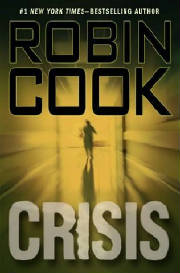
CRISIS. Robin Cook. Putnam’s 2006. When Dr. Craig Bowman is sued for malpractice by the widower of a hypochondriacal
woman, his wife asks her brother, New York medical examiner Jack Stapleton, to come to Boston to see if his insight might
help with Bowman’s defense. Stapleton hopes to get back to Manhattan in enough time to get married on Friday, but as
he gets more involved in his brother-in-law’s case there is as much suspense in wondering if he’ll help Bowman
out before his trial ends as there is in wondering if he’ll make it to the church on time. One of Stapleton’s
biggest hurdles is in managing to get past a ton of red tape so that he can perform an autopsy on the dead woman. Meanwhile,
he is attacked by a hulking associate of the widower’s lawyer, and Bowman’s children are tied up and threatened
over the pending autopsy.
Crisis is entertaining, but it certainly could have used a sharper editor. Cook spells out far too many dull, unnecessary
scenes (such as Stapleton asking where he can find a drug store) as if he needs to pad the book. At one point Cook mentions
that Stapleton has checked in on his brother-in-law in his bedroom while the latter was sleeping because he wanted to make
sure he was okay after taking sleeping pills on top of alcohol, yet the very next night Cook has him wandering the second
floor wondering which bedroom is Bowman’s. Cook simply forgets to tell us exactly who was responsible for tying up and
terrorizing Bowman’s children. Gee – doesn’t anybody bother editing or proofreading these books anymore?
Some fun, reasonably fast-paced despite the padding, but the ending is a bummer and the book is not a must-read by any means.
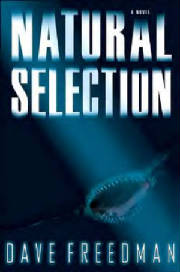 NATURAL SELECTION. Dave Freedman. Hyperion. 2006. Considering that the NBC series Surface, which was about the discovery of a huge new marine species barely lasted a season, you would think no major publisher
would want to take a chance on a book about the discovery of a new aquatic animal. But Hyperion is pushing this as a big beach
read a la Jaws. Once word of mouth gets around, however, it is unlikely that
Natural Selection will turn out to be another Jaws. While Jaws
wasn't really that great a book and would have been forgotten were it not made into a
movie by Spielberg, Natural Selection is even more forgettable. The story has
to do with the discovery of a new species of [manta] ray, which is larger, carnivorous, aggressive, highly intelligent, and
can even fly. A scientific team winds up battling one of these creatures in a forest filled with huge redwoods in the book's
final sections. The monster – herein christened a “demonray” -- isn't a bad invention, but Freedman simply
hasn't got the writing chops to make it or his story come fully to life. He introduces several realistic characters, but they
are so ordinary and dull that they do little to enliven the book's many chapters filled with scientific references and people
sitting around talking... and talking. There are some creepy moments in the redwood forest, but Freedman doesn't even develop
these scenes into the nightmarish moments the reader deserves, and the massive attack scene you've been waiting for never
quite develops. It is possible that Freedman wanted this to be taken as “serious” thriller and not a “cheesy”
monster book, but the fact remains that flying man-eating rays are the stuff of cheesy monster books, not serious thrillers.
The prose is serviceable at times, but completely lacks the sheer panache of the truly talented professional writer.
One suspects Freedman got this published less because of his writing skills than because he has a bachelor of science degree
from Princeton and a master's degree from Harvard. Despite this impressive pedigree and the author's research, much of the
“science” in this book is pretty suspect. The body count is low – and so are the thrills in a book that,
despite an interesting and eerie premise, takes forever to get going, never really grips even when it does, and in fact, is
pretty pedestrian, over-familiar and boring all told. Too bad -- a really talented horror writer might have made something
out of those darn “demonrays.”
VENGEANCE IS MINE. Mickey Spillane. Originally published in 1950,. Vengeance is Mine
is the third Mike Hammer novel and it's fairly tight and reasonably entertaining. Although Spillane's prose may not be as
“elegant” as Raymond Chandler's, his plots not as intricate as Ross MacDonald's, nor his stories as snappy as
Brett Halliday's, he was nevertheless an influential – and by no means a bad – writer. In this novel Hammer is
still in mourning over a lady he loved and had to kill, but is finally beginning to recognize that his secretary Velda may
be the gal for him. He runs into an old Army buddy, and the two get drunk and stagger into a hotel room. But when Hammer wakes
up in the morning, the buddy has shot himself with Hammer's gun, an apparent suicide – but Hammer believes otherwise
and sets out to solve the crime himself. His investigation leads him to an exclusive modeling agency, a corrupt photographer,
and an old enemy in a new guise. There's also a couple of gorgeous women, one of whom especially disturbs Hammer –
for good reason. Vengeance is Mine is really only an average hardboiled mystery novel,
but it is not without its points of interest – and unintentionally comical moments. Although we find out why he resists
in one case, the “ugly” Hammer has gorgeous women throwing themselves at him throughout the book and – incredibly
– walking out and leaving them unfulfilled, which is totally unbelievable, especially as Spillane describes these gals
as major sex bombs. What makes it more peculiar is that Hammer doesn't have any business that's so pressing that he can't
hang around for a quickie. Fearing that Velma's life is in danger, Hammer puts off running to her aid until she's practically
on the verge of being raped, even though nothing he does in between couldn't have waited until after he played Sir Galahad.
But the funniest – if very dated -- scene occurs when Hammer takes one gal to a place she recommends for great steaks
in Greenwich Village. It seems that Hammer is aware that the place is essentially gay, and has inexplicably been there more
than once! Now I'm not making insinuations about Mike Hammer, but this does seem a little odd, especially since one doesn't
get the impression that he went to this joint as part of an investigation. Earlier in the book Hammer expresses contempt for
uptowners who frequent Bowery dives to observe and ridicule the “freaks,” but that's just what he does at the
gay steak house! Well, nobody ever said Mickey Spillane was an intellectual. [To be fair, this book is nearly sixty years
old and can hardly reflect the more enlightened attitudes of today.] Hammer is presented not just as a mindless tough guy,
but a man who has a certain degree of sensitivity underneath the hard outer shell – which can be as hard as a rock.
The unexpected ending of the novel was in some ways ahead of its time and must have been quite shocking – if not disgusting
– to readers back in 1950. Recommended for the curious.
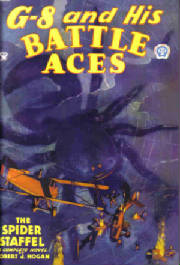
G-8 AND HIS BATTLE ACES. The Spider Staffel. Robert J. Hogan. Adventure House; 2004. [Originally published in
1934.] “G-8 and his Battle Aces” was a very popular pulp magazine of the 1930's which related the occasionally
bizarre adventures of a battle ace and his companions-in-warfare operating primarily overseas during WWI. Being a lover of
monster movies, I had always wanted to get my hands on a copy of this particular story which supposedly featured a gargantuan
spider – a pet of the Germans -- spinning a web that snatches up allied World War One planes like flies right out of
the air. What a concept! My first disappointment is that this Adventure House edition, while a reprint of the original, is
not a literal recreation of a pulp. Many readers will be delighted that the story is printed on thick paper stock that will
probably last forever, but it just doesn't look or feel like a real pulp [I imagine the real ones are incredibly expensive
as well as hard to find these days].
|
|
| An angry, heartbroken mother shoots at super-spy G-8. |
My second disappointment was that the huge, plane and pilot-devouring spider turns out to be a fake. Boo! Hiss! A clever
fake, admittedly. The Germans use balloons to raise electrified cables and ropes in the air, forming a “web,”
and then somehow project the image of a spider onto this device. It's up to the reader to figure out why the Germans would
imagine the Allies would believe in the existence of such a spider [they give it away when they say the spider is a tarantula,
which doesn't actually spin a web. Who says you can't learn anything from junk fiction?] The prose is merely functional, but
there are some surprises to the story, such as an excellent sequence when G-8 disguises himself as a dead German soldier and
once behind enemy lines is taken to see --- his mother! The story describes how uncomfortable G-8 feels deceiving the old
woman, who finally sees through the deception and shoots at the spy in a scene that is illustrated in the book. In another
surprising and twisted development, a young allied officer of German descent abruptly commits suicide when he discovers that
his brother – a German officer – betrayed his country, even though he was helping the allies! The scenes with
G-8 behind enemy lines are suspenseful, and remind one somewhat of James Bond novels [the pulps were a definite influence
on Ian Fleming], although they are nowhere near as good. The Spider Staffel isn't entirely mindless, containing G-8's
almost pacifist ruminations on war [which would not have played during WW2]. G-8 shows much compassion for the enemy, but
also kills them without compunction when he has to. William Schoell
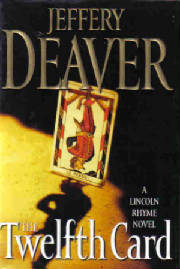 THE TWELFTH CARD. Jeffery Deaver. Simon and Schuster; 2005. Lincoln Rhyme and Amelia Sachs are
back in another puzzling adventure with some extremely sinister and dangerous antagonists. The criminalist gets involved when
a hit man goes after a sixteen- year-old Harlem girl for reasons that seem inexplicable. He leaves behind a tarot card of
the Hanging Man, which may or may not be another clue. Could it all be tied in with the research the girl, Geneva Settle,
was doing into an ancestor of hers who was, she believes, falsely accused of theft? And who hired the hit man in the first
place? As bodies pile up, and Sach's police colleague Lon Sellitto tries to deal with a bad case of the jitters due to his
close observation of a victim's death, Deaver takes us into the mind of the hit man, who hopes to escape the numbness he feels
even as he pushes innocent young women in front of buses. While The Twelfth Card is
not on the level of Deaver's Bone Collector or Vanished Man, it is highly suspenseful and flavorful. While some may find it to be a little bit too self-consciously
“pc,” it must be said that Geneva Settle is a very interesting and admirable character. A couple of the plot twists
don't quite ring true, but most readers will willingly go wherever Deaver wants to take them. A good, fast, frequently compelling
read. William Schoell.
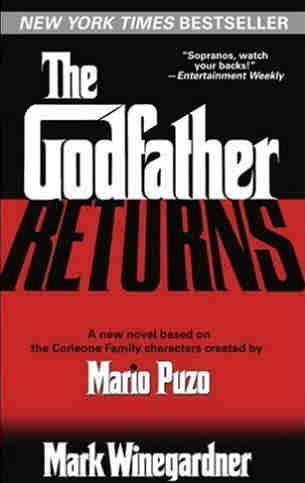
THE GODFATHER RETURNS. Mark Winegardner. Ballantine Books, 2004. This is a perfect example of how the publishing
industry can, come hell or highwater, turn a book– even a lousy one – into a big seller. Admittedly, with the
success of Mario Puzo’s The Godfather and the three films that were derived from it, there was a built-in audience
for this novel. While some Godfather fanatics may devour and love the book, others will be greatly disappointed. Winegardner
sets different chunks of his story in the time period between the three movies, filling in supposed holes in the narrative
but failing to provide a really good story of his own. The novel is very episodic, and the conflict between Michael Corleone
(who still comes off as a rather unreal character) and Nick Geraci never really comes to a boil. Worse, there is limited action
in the book; even with a small plane crash that kills some mafioso, and the late scene where a Corleone gal cuts her cheating
husband in half with her car, there aren’t any really memorably gruesome scenes in this. Finally Winegardner runs out
of story completely and resorts to cannibalizing books on Sinatra and the Rat Pack and telling the many-times-related (in
this case fictionalized) story of Sinatra (herein called Johnny Fontane) stumping for JFK and Joe Kennedy’s involvement
in the alleged mafia hit on Castro. There’s even the bit with Sinatra raging because JFK refuses to use his estate as
a west coast white house because of the former’s mobster ties. Almost in desperation, Winegardner decides to make Fredo
Corleone a tormented, self-hating closet queen who even murders one of his assignations. If this was done to make the book
more "contemporary," it was a very bad decision – as the book takes place mostly in the 1950's, it can’t exactly
display more enlightened attitudes toward gays, so the whole business with Fredo’s orientation is extremely dated and
even cliched. Winegardner hints that Fredo was molested by a priest he adored, but if Winegardner is suggesting that this
"turned" him gay, there’s no factual basis for this. [In general, authors should stay away from the gay stuff unless
they’re really sophisticated on the subject or at least do a little research.] True, guys like Fredo still exist today,
but they are a bit anachronistic. Winegardner is not a bad writer, and the characters are generally well-developed (for a
potboiler, that is) but The Godfather Returns never really erupts into something truly memorable, and is far less entertaining
than Puzo’s original.
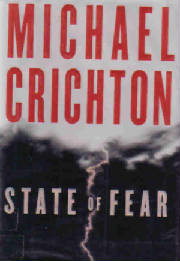 STATE OF FEAR. Michael Crichton. HarperCollins; 2004. This book meanders along for over a quarter
of its considerable length, but stay with it – it eventually becomes quite gripping. Using the thriller format, Crichton
attacks the very concept of global warming, claiming that it's about as significant a threat to us and our planet as Y2K was
– and we all know what that amounted to -- nothing. The villains are environmentalists – eco-terrorists
– who hope to alert people to the dangers of global warming by creating their own weather disasters they can then attribute
to warming. The fact that a great many people will die to “prove” a point doesn't seem to concern them, even though
the whole idea is actually to save lives. (Sadly, this is not at all implausible.)
A small team races around the globe trying to prevent these man-made disasters, including an attempt to create a thunderous
tsunami in the climax (the recent tsunami was caused by a massive earthquake in the Indian Ocean, not by weather conditions
or “global warming”). The characters, which include a lawyer-hero, a multi-millionaire who backs environmental
causes, a Robert Redford-Martin Sheen type celebrity environmentalist, various male and female agents and such, aren't badly
drawn, and the pace is generally swift despite long but fascinating discourses on the pros and cons of global warming. The
scene when the group rush to prevent a flood that will wipe out many families of picnickers is nail-biting, but the climactic
scenes have a few too many improbable moments. Crichton adds a grisly if over-the-top touch when one of the less likable characters,
whose fate goes un-mourned, gets eaten by cannibals – while alive. Not without flaws, but a good, thought-provoking
read to be sure. William Schoell
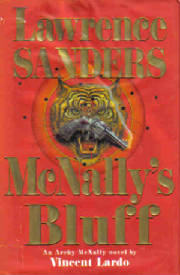 MCNALLY'S BLUFF. Lawrence Sanders and Vincent Lardo. In this outing Arch McNally gets involved
with a pint-sized circus showman whose out-sized wife is murdered on the very night of an unveiling of a complicated maze
on the showman's property. The question is: How did the killer or killers manage to get the dead heavyweight wife from her
room to the middle of the maze – and who killed her? This is a meandering, not terribly compelling mystery in the series,
and the appeal of the characters – from McNally himself down to the mail room idiot Binky Watrous – is running
thin. Writer Vincent Lardo has (a couple of books ago) given McNally a new girlfriend and gotten him
out of his parents' house, but he can't do anything to make this somewhat unreal character any more believable or dimensional.
The McNally books have always been fun, but this one is a bit on the dull and over-familiar side. There's also a dated quality
to the books in that McNally supposedly remains in his thirties but some of his (trite) observations seem to be made by a
much older man. And the “sophistication” of the character and the stories always seems a trifle forced and phony.
Still, a more interesting plot and a much more solid mystery may bring new life to this old series yet. Time will tell. --
William Schoell
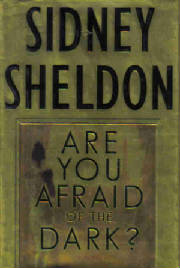 ARE YOU AFRAID OF THE DARK? Sidney Sheldon. William Morrow; 2004.
Once upon a time Sidney Sheldon, a former screenwriter, showed real promise
as a novelist. There were harrowing moments in his first big hit, The Other Side of Midnight, and the early sections
of Master of the Game had an almost Dickensian tone to them. These sequences dealt in a highly compelling and intense
fashion with the struggles of a young man to get a fortune in diamonds against almost overwhelming odds, while they also detailed
his shocking if understandable change in character. These chapters had a certain intrinsic power, but the rest of the book
– with its evil twins and all – while entertaining, seemed cobbled together from a lot of old movies. Since then
Sheldon has had a string of bestsellers, most of which are quite readable (and you forget them the minute you put one down,
as my sister Carol Altomare has noted), but the promise seen in the early days has basically been
frittered away. Now Sheldon's books often read like mere outlines waiting for someone to fill them in with three-dimensional
characters and rich descriptions. Still, the darn things are a fun way to wile away some time on the beach.
In his latest book, Sheldon presents two young women who have
recently been widowed. Somebody is out to kill them, too, and together they manage to dodge and outwit hit men at every turn.
One of the ladies is a fairly new stereotype: the black fashion model who has risen from nothing and has an attitude. {Gee
– never seen that one before!] The villain in this, revealed almost at the outset, is truly loathsome and his
end isn't horrible enough by far. Seems he's killing off anyone who knows anything about a project he's put together to control
the world's weather. This book seems quite topical – what with Sheldon's intimations that the major powers already have the ability to control the weather – in these days of tidal waves and unexpected storm systems.
[Just the other day a 70 foot wave almost swamped a cruise ship. What's going on here?] But don't expect anything the least
bit intellectual or with much serious resonance. It's entertaining, fast-paced, and has at least one good twist I didn't see
coming but should have. Sheldon is no Agatha Christie when it comes to intricate, inventive plotting, but he can slip a few
things by you if you're not really paying attention. And who pays that much attention when they're reading Sidney Sheldon?
-- William Schoell
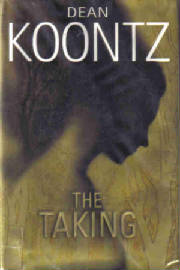 THE TAKING. Dean Koontz. 2004. Bantam Books Hardcover. In a novel that reads very much like his earlier (and superior)
Phantoms, Koontz presents us with a fairly average young couple (what else?) with
dysfunctional histories (of course) who find that the world is seemingly being changed almost over night, with horrific occurrences
everywhere from space to big cities to the small town they live in. It would be criminal to give anything away, because for
much of its length The Taking is a gripping, scary, intensely suspenseful thriller
that works beautifully despite some missteps, dopey moments, and really purple prose. One of the best scenes has a group of
frightened people in a bar confronted with a vision of their own mangled future-corpses in the mirror, and there's some “fun,”
if cheesy, stuff involving a giant bug and lots of fungi containing human faces. Some critics were disappointed that Koontz
didn't inject more humor into the book, but this is absolutely the wrong story for it; in fact there's some campy dialogue
that shatters the carefully wrought atmosphere. However ... SPOILER ALERT ... operating under some kind of “new age”
lunacy, Koontz has come up with an muddled, religious ending that may make a lot of readers want to gag. It would have been
better if he had brought back the creature from Phantoms! While it may be true that in a “faithless age” an honest-to-goodness “miracle”
might be taken as the work of extraterrestrials, who says this is a “faithless” age, what with the religious right
eroding the separation of church and state even as we speak, not to mention the sub-literate belief in “angels?”
Either Koontz has cynically tapped into the moron market for another bestseller, or he's just as shallow as I've always suspected.
The book is a pretty good chiller but for those final chapters...! I've skipped
a lot of Koontz's books and now I remember why. -- T. Barnes
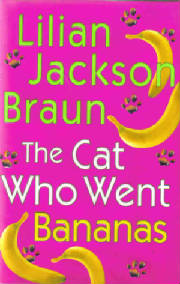 THE CAT WHO WENT BANANAS. Lilian Jackson Braun. Another installment in the life of Qwilleran-of-the-mustache,
his gal-pal Polly, and their friends and, of course, cats. You keep telling yourself you'll never read another one of these,
but the darn things sort of grow on you, don't they? What keeps the readers coming back is Braun's at times charming depiction
of rural life and quaint characters – it sure ain't the plots. To say that Miss Braun is not exactly on the level of
Agatha Christie when it comes to fashioning solid mystery storylines is a massive understatement. The books just meander along,
with Braun now and then throwing in a reminder that, oh yes, there is a mystery of some sort going on, a dead body or something
or other. This book has to do with a handsome actor who recently lost his older and wealthier wife in mysterious circumstances.
Now he's in town helping out at the local theater and charming all the ladies, Polly as well. Braun introduces a mystery or
two but neither she nor Qwilleran ever really come up with a complete solution – and if that's not a new twist I don't
know what is! Still, the book is a fun, fast – if ultimately frustrating -- read and Braun is to be commended for presenting
people who have a strong interest in history and culture -- Qwilleran even listens to opera now and then – even if she
keeps writing the same book over and over and over. Although Qwilleran has never really come off like a real person, if you
read enough of Braun's books about him you'll eventually swear that he exists.
Perhaps the next book will be entitled The Cat Who Dropped Dead. Qwilleran will finally realize that he's gay; Polly will run off with a man half her age (Derek Cuttlebrink?); and
Koko and Yum Yum will move in with Qwill's Aunt Fanny, who turns out not to be dead after all, and
wants all of her money back. -- William Schoell
Monday Mourning. Kathy Reichs. Scribner.
Kathy Reichs' latest novel Monday Mourning features her alter-ego Temperance
Brennan in another mystery that's a little less gruesome than some of her escapades. In this one she investigates when the
bones of young women are found beneath a pizza parlor. Brennan must learn how old the bones are before she can proceed. If
they are too old, they would be considered “historic” (what actually happened in real life) and the murders would
remain unsolved in favor of more recent cases. In two much less interesting sub-plots, Brennan's friend comes up to Montreal
with thoughts of divorcing her husband; and Brennan is afraid that her boyfriend, Detective Ryan, may be cheating on her.
Not all of Reich's mysteries are equally gripping, but this one works very well for the most part. One problem is that Brennan
behaves quite stupidly in the climax, and it seems a little far-fetched that she wouldn't figure out who the killer is (you
probably will). She also doesn't handle her relationship with Ryan all that well. Normally characterization and personal lives
are welcome in mystery novels, if they're well handled. The “personal” stuff in Patricia Conway's novels eventually
became quite tiresome; let's hope that doesn't happen with Reichs.
3rd Degree. James Patterson and Andrew Gross. Little, Brown.
This is another story featuring the “Women's Murder Club,” a group of friends and professionals who help
each other solve crimes. In this super fast-paced thriller, the group is up against a mysterious figure who seems to be killing
individuals for political motives. First a townhouse is blown up, then a man is killed via use of deadly ricin. One of the
women in the group is also targeted. All of this is heading toward a deadly denouement involving the vice president of the
United States which must be stopped at all costs. But are the motives of the killer or killers as obvious as they seem? There
are some good twists and a generous amount of suspense in this book, which is certainly a good beach read in spite of the
fact that it brings up some serious issues in its pages. This book seems a little less “mindless” than most of
Patterson's works. We must assume we can thank his co-author Andrew Gross (who isn't even given a brief biography on the dust
jacket!) for that. With very short chapters, paragraphs and sentences – like a young adult novel -- it certainly reads
at a breathless pace. Another writer may have been able to enrich the descriptions and characterizations without sacrificing
any of the suspense, but for a quick thrill, this book is just the ticket.
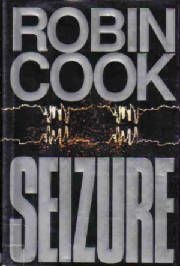 Seizure. Robin Cook. Putnam's.
Many of Robin Cook's medical thrillers are done in by weak characterization,
over-familiar plots, and pedestrian writing, but now and then Cook hits one out of the ball park. Seizure is his best
thriller since Vital Signs, and benefits from a terrific premise based on the current furor over stem cell research.
Dr. Daniel Lowell agrees to treat a conservative southern senator, Ashley Butler, for his Parkinson's disease in exchange
for the senator's help in blocking legislation that would prohibit research that could benefit millions via stem cell experimentation.
Both men have massive egos, and their respective female assistants (Lowell's assistant is also his lover) have trouble keeping
them in check. Butler wants the cells used in his treatment to come from the blood of Christ on the Shroud of Turin! Lowell
actually manages to procure it, but has to deal with ruthless quack doctors (seen in at least one previous Cook novel) who
have fled Boston after one disaster and set up shop in the Bahamas, outside of U.S. Jurisdiction – and where Butler
will receive his treatment. The only misstep in this highly entertaining, fast-paced thriller is Cook's use – yet again!
-- of an uninteresting hit man who comes to the Bahamas to cause some minor and distracting mischief. Otherwise, this topical
novel is one of Cook's best. In the novel itself and in his Author's Note Cook makes clear that cloned cells used in stem
cell research are harvested long before an embryo is formed. With a great premise, strong plot, and interesting characters,
Cook has come up with a winner this time.
|

